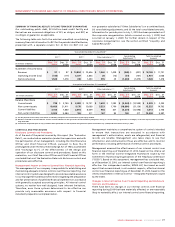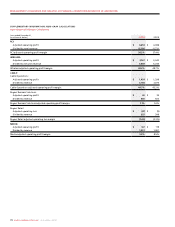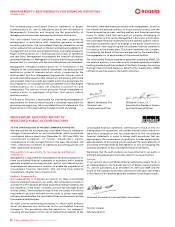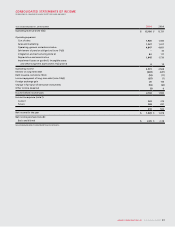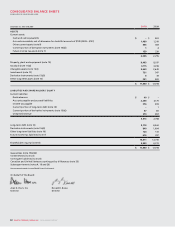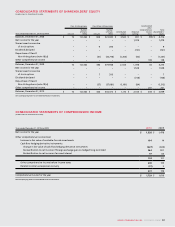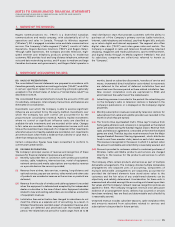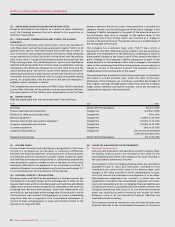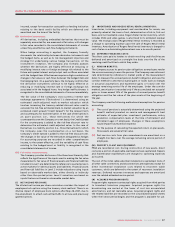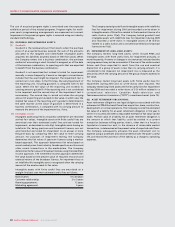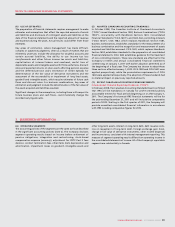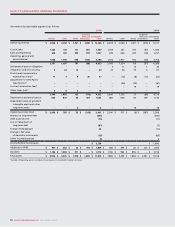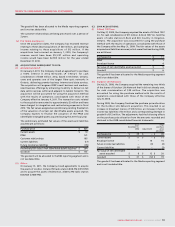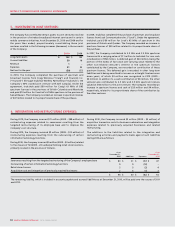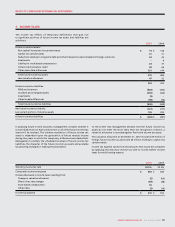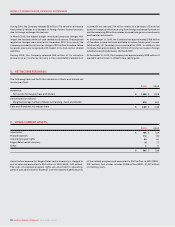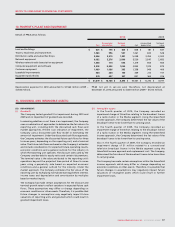Rogers 2010 Annual Report Download - page 83
Download and view the complete annual report
Please find page 83 of the 2010 Rogers annual report below. You can navigate through the pages in the report by either clicking on the pages listed below, or by using the keyword search tool below to find specific information within the annual report.
NOTES TO CONSOLIDATED FINANCIAL STATEMENTS
ROGERS COMMUNICATIONS INC. 2010 ANNUAL REPORT 87
incurred, except for transaction costs paid to a lending institution
relating to the bank credit facility which are deferred and
amortized over the term of the facility.
(ii) Derivative instruments:
All derivatives, including embedded derivatives that must be
separately accounted for, are measured at fair value, with changes
in fair value recorded in the consolidated statements of income
unless they are effective cash flow hedging instruments.
When hedge accounting is applied, the Company formally
documents the relationship between derivative instruments and
the hedged items, as well as its risk management objective and
strategy for undertaking various hedge transactions. At the
instrument’s inception, the Company also formally assesses
whether the derivatives are highly effective at reducing or
modifying interest rate or foreign exchange risk related to the
future anticipated interest and principal cash outflows associated
with the hedged item. Effectiveness requires a high correlation of
changes in fair values or cash flows between the hedged item and
the hedging item. On a quarterly basis, the Company confirms that
the derivative instruments continue to be highly effective at
reducing or modifying interest rate or foreign exchange risk
associated with the hedged items. Any hedge ineffectiveness is
recognized in the consolidated statements of income immediately.
The fair value of the Company’s cross-currency interest rate
exchange agreements (“Derivatives”) is determined using an
estimated credit-adjusted mark-to-market valuation which
involves increasing the treasury-related discount rates used to
calculate the risk-free estimated mark-to-market valuation by an
estimated credit spread (“Credit Spread”) for the relevant term
and counterparty for each Derivative. In the case of Derivatives in
an asset position (i.e., those Derivatives for which the
counterparties owe the Company on a net basis), the Credit Spread
for the counterparty is added to the risk-free discount rate to
determine the estimated credit-adjusted value. In the case of
Derivatives in a liability position (i.e., those Derivatives for which
the Company owes the counterparties on a net basis), the
Company’s Credit Spread is added to the risk-free discount rate.
The changes in fair value of the Derivatives designated as hedges
for accounting purposes are recorded in other comprehensive
income, to the extent effective, until the variability of cash flows
relating to the hedged asset or liability is recognized in the
consolidated statements of income.
(iii) Fair value measurements:
The Company provides disclosure of the three-level hierarchy that
reflects the significance of the inputs used in making the fair value
measurements. Fair value of financial assets and financial liabilities
included in Level 1 are determined by reference to quoted prices in
active markets for identical assets and liabilities. Financial assets
and financial liabilities in Level 2 include valuations using inputs
based on observable market data, either directly or indirectly
other than the quoted prices. Level 3 valuations are based on
inputs that are not based on observable market data.
(I) NET INCOME PER SHARE:
The diluted net income per share calculation considers the impact of
employee stock options using the treasury stock method. There is no
dilutive impact of employee stock options after May 28, 2007, due to
the amendment to attach cash-settled SARs to all new and previously
granted options.
(J) INVENTORIES AND ROGERS RETAIL RENTAL INVENTORY:
Inventories, including equipment and merchandise for resale, are
primarily valued at the lower of cost, determined on a first-in, first-out
basis, and net realizable value. Rogers Retail rental inventory, which
includes DVDs and video games, is amortized to its estimated residual
value. The residual value of Rogers Retail rental inventory is recorded as
a charge to operating expense upon the sale of Rogers Retail rental
inventory. Amortization of Rogers Retail rental inventory is charged to
cost of sales on a diminishing balance basis over a six-month period.
(K) DEFERRED FINANCING COSTS:
The direct costs paid to lenders to obtain revolving credit facilities are
deferred and amortized on a straight-line basis over the life of the
revolving credit facilities to which they relate.
(L) PENSION BENEFITS:
The Company accrues its pension plan obligations as employees render
the services necessary to earn the pension. The Company uses a discount
rate determined by reference to market yields at the measurement
dates to measure the accrued pension benefit obligation and uses the
corridor method to amortize actuarial gains or losses (such as changes
in actuarial assumptions and experience gains or losses) over the
average remaining service life of the employees. Under the corridor
method, amortization is recorded only if the accumulated net actuarial
gains or losses exceed 10% of the greater of accrued pension benefit
obligation and the fair value of the plan assets at the beginning of
the year.
The Company uses the following methods and assumptions for pension
accounting:
(i) The cost of pensions is actuarially determined using the projected
benefit method prorated on service and management’s best
estimate of expected plan investment performance, salary
escalation, compensation levels at the time of retirement and
retirement ages of employees. Changes in these assumptions
would impact future pension expense.
(ii) For the purpose of calculating the expected return on plan assets,
those assets are valued at fair value.
(iii) Past service costs from plan amendments are amortized on a
straight-line basis over the average remaining service period of
employees.
(M) PROPERTY, PLANT AND EQUIPMENT:
PP&E are recorded at cost. During construction of new assets, direct
costs plus a portion of applicable overhead costs are capitalized. Repairs
and maintenance expenditures are charged to operating expenses
as incurred.
The cost of the initial cable subscriber installation is capitalized. Costs of
all other cable connections and disconnections are expensed, except for
direct incremental installation costs related to reconnect Cable
customers, which are deferred to the extent of reconnect installation
revenues. Deferred reconnect revenues and expenses are amortized
over the related estimated service period.
(N) ACQUIRED PROGRAM RIGHTS:
Program rights represent contractual rights acquired from third parties
to broadcast television programs. Acquired program rights for
broadcasting are carried at the lower of cost less accumulated
amortization, and net realizable value. Acquired program rights and
the related liabilities are recorded on the consolidated balance sheets
when the licence period begins and the program is available for use.


